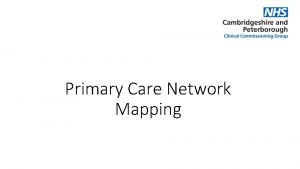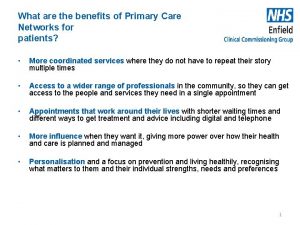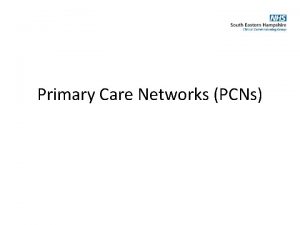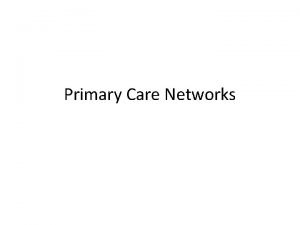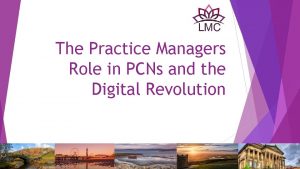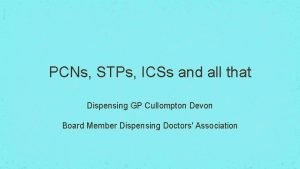Primary Care Networks Primary care networks PCNs form







- Slides: 7

Primary Care Networks • Primary care networks (PCNs) form a key building block of the NHS long-term plan. Bringing general practices together to work at scale has been a policy priority for some years for a range of reasons, including improving the ability of practices to recruit and retain staff; to manage financial and estates pressures; to provide a wider range of services to patients and to more easily integrate with the wider health and care system. • While GP practices have been finding different ways of working together over many years – for example in super-partnerships, federations, clusters and networks – the NHS long-term plan and the new five-year framework for the GP contract, published in January 2019, put a more formal structure around this way of working, but without creating new statutory bodies. • Since 1 July 2019, all except a handful of GP practices in England have come together in around 1, 300 geographical networks covering populations of approximately 30– 50, 000 patients. This size is consistent with the size of primary care homes, which exist in many places in the country, but much smaller than most GP federations. Around 50 networks, usually in very rural areas, will cover a population of less than 30, 000, but most are bigger than 50, 000. 1

Item 1 Item 2 Item 3 Item 4 Item 5 21 Primary Care Networks across Cambridgeshire and Peterborough ü PCNs were asked to submit an expression of interest on the 15 May 2019. ü Initial details • PCN member practices • Sum of member practice list sizes as at January 2019 • Name of the appointed clinical director • Details of PCN’s nominated payee • Map of PCN area ü Primary Care Commissioning Committee sign off final approval. ü 1 July Contract Go Live • 100% population coverage • 100% GP Practices signed up ü Data Sharing Agreement ü Baseline Workforce signed off (5 additional posts) ü Network Agreement signed off 2

Item 1 Item 2 Item 3 Item 4 PCNs & Clinical Directors North PCN Name South Clinical Director PCN Name Clinical Director A 1 Network Dr Jo Pritchard Cam Medical Network Dr Marie Waters Dr Stephen Ford BMC Paston Dr Adnan Tariq Cambridge City Dr Tom Shackleton Dr Rachel Harmer Central Thistlemoor Dr Neil Modha Dr Toseef Sethi Cambridge North Villages Dr Craig Needs Dr Simon Poole Octagon Dr Sanath Yogasundram Cantab Medical Practices Dr Kevin Webb Huntingdon Dr Duncan Blake Ely North Dr Zoe Hutchinson Wisbech Dr Mandeep Sira Ely South Dr Richard Brixey Peterborough 1 Dr Tabasum Shah Granta Medical Practice Dr Duncan Sconce Fenland Dr Ben Curtis Meridian Dr Vanessa Lockyer South Fenland Dr Angela Stevens-King Dr Simon Hambling Cambridge City 4 Dr Cathy Bennett South Peterborough Dr Peresh Gela St Ives Dr Sean Culloty St Neots Dr Stuart Sheilds Item 5

PCN Focus for next 6 months July 2019 - December 2019 Establish your network • Governance • Develop effective relationships • Identity Complete NHSE Maturity Matrix • Complete baseline assessment • Identify areas of support • Agree bespoke plan PCN Development Framework of Support Workforce • Practices are registered on NWRS • Baseline maintained – additional workforce • Recruitment of new roles • Social Prescribing • Clinical Pharmacists

Item 1 Item 2 Item 3 Item 4 Item 5 The Primary Care Network (PCN) Maturity Matrix outlines the core components that underpin the successful development of networks. • It sets out a progression model that evolves from the initial steps and actions to grow the scope and scale of the role of networks in delivering greater integrated care and population health for neighbourhoods. • The matrix was built through learning from the initial wave of Integrated Care Systems who commenced early work on the design and develop of PCNs during 2018/19. It has since been refreshed to take account of the NHS Long Term Plan and the GP Contract Framework. • It is designed to support network leaders, working in collaboration with their commissioners and other local leaders within neighbourhoods, to work together to understand the development journey both for individual networks, and how groups of networks can collaborate together in the planning and delivery of care. • It will allow local leaders • To identify where PCNs are in their journey of development • Develop plans for further development of the network • Identify support needs – using the PCN Development Support Prospectus as a guide for framing support plans

Item 1 Characteristics of Integrated Neighbourhoods Item 2 Item 3 Item 4 Item 5

Item 1 Item 2 Item 3 Item 4 Integrated Neighbourhoods Accelerator Sites Granta Integrated Neighbourhood Wisbech Integrated Neighbourhood Launch event held Multi-organisational on 08 July including Board including over 50 members of CPFT, Council, the local community, CCG and CUH voluntary sector and representation health and social leading on priority care providers. projects focusing on: diabetes, wound Further event has care, neurology and taken place a Wellbeing Hub. The Accelerator sites receive an offer of support which includes: • Establishing a multi-organisational Steering Group/Board • Support to create and fund engagement events and workshop to design a local vision • Data and analytics support • Tools and learning from the first Integrated Neighbourhoods • Support and resource to design and implement local innovation projects Second wave of Accelerator sites are: Cambridge North Villages, Cantab, South Ely, Thistlemoor & Central, BMC Paston and South Peterborough It is envisioned that there will be full coverage of Integrated Neighbourhoods in phases over the next three years. Item 5
